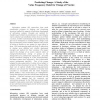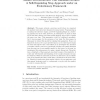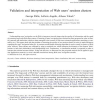45 search results - page 6 / 9 » Applying causal inference to understand emergent behavior |
HICSS
2009
IEEE
14 years 2 months ago
2009
IEEE
Information systems (IS) researchers have made considerable progress on defining and formalizing structured methods to support collaborative development of information systems. Co...
JASIS
1998
13 years 7 months ago
1998
This article develops a theoretical framework of distributed representations to explore the representational properties in group problem solving. The basic principle of distribute...
EVOW
2011
Springer
12 years 11 months ago
2011
Springer
This paper extends a previous model where we examined the markets’ microstructure dynamics by using Genetic Programming as a trading rule inference engine, and Self Organizing Ma...
IPM
2007
13 years 7 months ago
2007
Understanding users’ navigation on the Web is important towards improving the quality of information and the speed of accessing large-scale Web data sources. Clustering of users...
INFOCOM
2006
IEEE
14 years 1 months ago
2006
IEEE
— With the explosive growth of network techniques, in particular wireless communications, the traditional centralized, fixed networks can no longer satisfy the enormous demands ...



